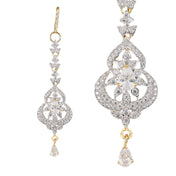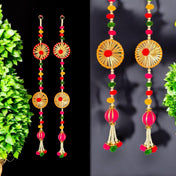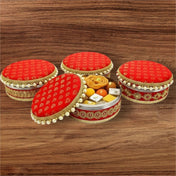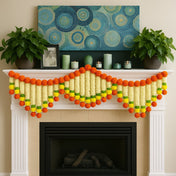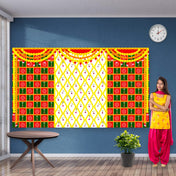Indian wall art holds a deep cultural and spiritual significance that transcends time and generations. With a rich history rooted in traditions that date back thousands of years, every painting, sculpture, and decorative piece tells a story that offers a glimpse into the soul of India. Whether it's a painting of a Hindu deity, an intricate metal wall hanging, or an elaborate tapestry, the meanings behind Indian wall art can provide a deeper connection to Indian culture, spirituality, and history. In this article, we will explore the hidden meanings behind Indian wall art and how these pieces can add meaning, elegance, and vibrancy to your living spaces.
The Evolution of Indian Wall Art
Indian art has evolved over thousands of years, influenced by the diverse cultures, religions, and geographical regions across the country. From ancient frescoes in temples to modern-day artworks, Indian wall art offers a fascinating journey through time. Historically, wall art in India was often created to tell stories of gods and goddesses, celebrate royal victories, or depict life in rural and urban settings. The most common forms of Indian wall art include traditional paintings like Madhubani, Warli, and Tanjore paintings, as well as sculptures, brass work, and textile art.
As time progressed, Indian wall art began to integrate various modern elements, while still maintaining its rich spiritual and symbolic essence. Today, you can find a variety of Indian-inspired wall art that blends traditional and contemporary designs, making it the perfect addition to any home or office.
For those seeking authentic and high-quality Indian wall art, LoveNspire offers a curated selection of products that bring timeless cultural aesthetics to your spaces. Check out the Arangetram Natraj Backdrop Cloth Banner, an exquisite depiction of Lord Shiva in dance, or the Decorative Brass Dancing Ganesha Spoon Wall Art, a beautiful way to invite prosperity and happiness into your home.
The Spiritual Significance of Indian Wall Art
One of the most prominent features of Indian wall art is its spiritual significance. For centuries, various forms of art in India have been used to invoke divine blessings, seek protection, and connect with higher realms of existence. Whether it's the depiction of gods and goddesses or sacred symbols like the Om or Swastika, Indian wall art is deeply intertwined with the spiritual life of the people.
Hindu wall art, for instance, often features deities like Shiva, Vishnu, and Lakshmi, each representing different aspects of the divine. Shiva, the god of destruction and transformation, is frequently depicted in dance poses, symbolizing the rhythm of the universe. These images not only serve as devotional pieces but also remind the viewer of the eternal cycle of creation, preservation, and destruction.
Similarly, the art of Lord Ganesha, the elephant-headed god of wisdom and remover of obstacles, is often found in many Indian homes. The Decorative Brass Dancing Ganesha Spoon Wall Art is a prime example of such a spiritual piece. It can be hung in living rooms, offices, or entrances to invite prosperity and harmony into the space.
These artworks aren't merely decorative; they are meant to inspire reverence and reflection. The act of placing such art on the wall is a subtle yet powerful form of meditation, encouraging the viewer to contemplate the divine presence in their lives.
Different Types of Indian Wall Art
Indian wall art comes in various forms, each carrying its own unique set of meanings and traditions. Understanding the different types can help you choose the perfect piece to complement your living space. Let’s explore some popular types of Indian wall art:
1. Madhubani Paintings
Originating from the Mithila region in Bihar, Madhubani paintings are characterized by intricate patterns, bright colors, and themes inspired by nature, mythology, and religious events. The paintings often depict gods, animals, and scenes from everyday life. The symbolism in Madhubani paintings is rich, with each color and design element holding meaning. For instance, the use of bright red symbolizes vitality, while peacocks often represent beauty and grace.
If you're looking for a vibrant and meaningful addition to your wall, consider exploring modern interpretations of Madhubani paintings like those available at LoveNspire.
2. Warli Art
Warli art, a tribal art form from Maharashtra, is known for its simple, monochromatic designs depicting human figures, animals, and nature. The artwork is often painted using rice paste on mud walls and is a reflection of the tribal people's deep connection with nature. The geometric shapes and symbols used in Warli paintings represent the harmony between the human world and the natural environment.
Warli art is perfect for adding an earthy, grounded feel to your space. For a contemporary take, check out Annam Wall Hanging Frame Brass Artwork, which blends traditional aesthetics with modern framing techniques.
3. Tanjore Paintings
Tanjore paintings, originating from Tamil Nadu, are famous for their rich colors, surface richness, and compact composition. These paintings often depict Hindu gods, goddesses, and saints, with a special focus on figures like Lord Krishna and Goddess Lakshmi. The paintings are distinguished by the use of gold foil to add texture and shine, which enhances the visual impact.
Tanjore paintings are not only a symbol of religious devotion but also of artistic excellence. The intricate details and the use of gold make them a luxurious and striking addition to any home.
4. Brass Wall Art
Brass is widely used in Indian art to create intricate sculptures and wall hangings. These pieces often depict religious figures, animals, or symbolic objects. The use of brass adds a timeless and vintage appeal to any room. The Decorative Brass Dancing Ganesha Spoon Wall Art from LoveNspire is an example of how brass can be used to create an elegant yet meaningful decoration for your home.
5. Textile Art
India has a rich tradition of textile art, and many wall hangings feature intricate embroidery or weaving. These include tapestries, quilts, and embroidered panels depicting scenes from Indian mythology, daily life, or abstract designs. Textile art adds texture and warmth to a room, making it ideal for living rooms, bedrooms, or meditation spaces.
How to Incorporate Indian Wall Art into Your Home

Incorporating Indian wall art into your home is a great way to bring culture, spirituality, and elegance into your space. Here are some tips to help you style your home with Indian wall art:
1. Choose the Right Theme for Each Room
When selecting Indian wall art for your home, consider the theme of each room. For the living room, you might want to opt for more decorative and vibrant pieces like a Decorative Brass Dancing Ganesha Spoon Wall Art to create a welcoming, positive atmosphere. For your bedroom, choose soothing pieces that promote calmness and tranquility, such as those depicting serene deities or nature scenes.
2. Mix Traditional and Modern Designs
Don’t hesitate to mix traditional Indian art forms with modern designs. A contemporary setting can be enhanced with a traditional piece like a Madhubani or Tanjore painting. The contrast between modern furniture and intricate Indian artwork can create a stunning visual effect. The Annam Wall Hanging Frame is a great example of how modern framing can highlight traditional artwork.
3. Use Wall Art to Create Focal Points
Indian wall art can be a great way to create a focal point in a room. A large statement piece, such as an Arangetram Natraj backdrop, can serve as the center of attention. This not only adds an aesthetic appeal but also draws attention to the cultural significance behind the artwork.
4. Complement with Other Decorative Items
Pair Indian wall art with other decorative items, such as traditional pottery, sculptures, and brass décor, to create a cohesive theme. For example, placing a brass art piece like the Evil Eye Hanging Decoration next to a Madhubani painting can tie the elements together beautifully while offering added protection and charm.
Conclusion
Indian wall art offers much more than just visual beauty; it provides a window into the cultural and spiritual world of India. From the vibrant colors of Madhubani paintings to the intricate designs of brass wall hangings, each piece carries with it a story that is deeply rooted in tradition and meaning. By incorporating Indian wall art into your home, you are not only beautifying your space but also embracing the wisdom and energy these pieces bring.
At LoveNspire, we believe in offering you the finest selection of Indian-inspired wall art that blends culture, spirituality, and modern style. Whether you are looking for a divine depiction of Lord Shiva, a charming Ganesha, or a decorative brass piece, LoveNspire has something to match your aesthetic needs.
Explore our full range of home décor at LoveNspire and discover the perfect piece that will bring beauty, meaning, and prosperity into your space.











